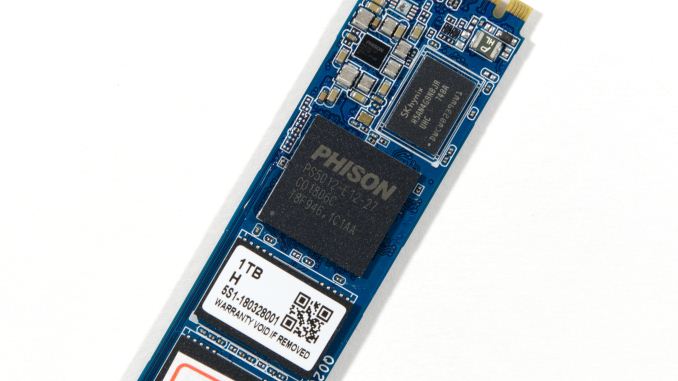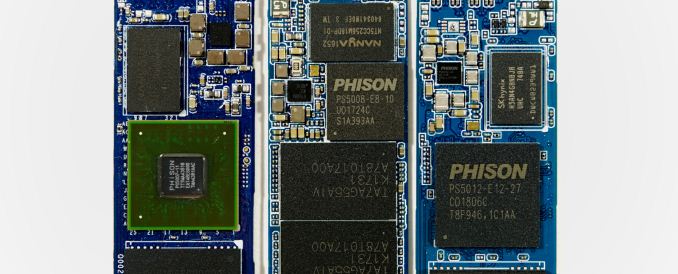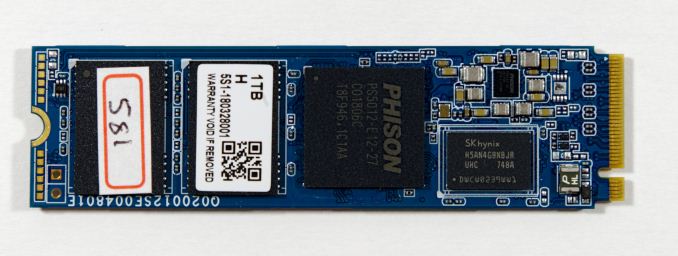The Phison E12 Reference Design Preview: A Next-Gen NVMe SSD Controller
by Billy Tallis on July 18, 2018 10:30 AM EST
Phison is one of the most successful SSD controller designers that sells controllers on the open market. Phison's controllers range from tiny low-power chips for USB flash drives and memory cards up to high-end NVMe SSD controllers, ending up in drives such as the Kingston A1000, and the Patriot Hellfire. The Phison E12 is its latest flagship NVMe controller intended for high-end consumer SSDs and enterprise SSDs. We have an engineering sample of Phison's reference design for a consumer M.2 NVMe SSD with the E12 controller and 1TB of Toshiba 3D TLC NAND flash memory. Phison — and the many brands that base their SSDs on Phison designs — are hoping that this new combination will be able to compete against top SSDs from the vertically-integrated giants like Samsung and Western Digital.
Phison has a close relationship with Toshiba, and most Phison-based consumer SSDs from the past several years have used Toshiba NAND flash. This was a bit of a hindrance for brands using Phison controllers during the year where Samsung and IMFT were shipping 3D NAND but Toshiba was still primarily producing 15nm planar NAND. Phison's first NVMe controller (E7) was used almost exclusively with Toshiba's 15nm MLC NAND and consequently those drives tended to have more limited capacities and higher per-GB prices than their competition.
The situation this year is quite different. Toshiba's 64L 3D TLC is very competitive, and when paired with the right controller it can deliver great performance (as seen in the WD Black with SanDisk NAND) and great power efficiency (as seen in the Toshiba XG5).
| Phison NVMe SSD Controller Comparison | ||||||
| Controller | E12 | E12C | E8 | E8T | E7 | |
| Model Number | PS5012-E12 | PS5012-E12C | PS5008-E8 | PS5008-E8T | PS5007-E7 | |
| Host Interface | PCIe 3.0 x4 | PCIe 3.0 x4 | PCIe 3.0 x2 | PCIe 3.0 x2 | PCIe 3.0 x4 | |
| Protocol | NVMe 1.3 | NVMe 1.2 | NVMe 1.1b | |||
| NAND Channels | 8 | 4 | 4 | 4 | 8 | |
| NAND Chip Enable lines | 32 | 16 | 32 | 32 | 64 | |
| Typical NAND | 3D TLC, 3D QLC | 64L 3D TLC | 15nm MLC | |||
| Max Capacity | 8 TB | 2 TB | 2 TB | 1 TB | 2 TB | |
| DRAM Support | DDR4, DDR3L | DDR3(L) | None (HMB) | DDR3(L) | ||
| Error Correction | LDPC, StrongECC | StrongECC | BCH | |||
| Manufacturing Process | TSMC 28nm | UMC 40nm | TSMC 28nm | |||
| Sequential Read | 3200 MB/s | 1700 MB/s | 1600 MB/s | 1600 MB/s | 2600 MB/s | |
| Sequential Write | 3000 MB/s | 1700 MB/s | 1300 MB/s | 1300 MB/s | 1300 MB/s | |
| 4KB Random Read | 600k IOPS | 340k IOPS | 240k IOPS | 120k IOPS | 300k IOPS | |
| 4KB Random Write | 600k IOPS | 400k IOPS | 220k IOPS | 130k IOPS | 200k IOPS | |
| Retail SSD Availability | Soon | ? | Q4 2017 | ? | Q1 2016 | |
Late last year, Phison's E8 controller arrived in the retail market with the MyDigitalSSD SBX. This second-generation NVMe controller is aimed at the low-end NVMe SSD market: it features fewer PCIe lanes and NAND channels than a typical high-end SSD and is fabbed on a cheaper 40nm process rather than the 28nm process used by most cutting-edge SSD controllers. The Phison E12 is the high-end member of this second generation, and it brings all the features we expect from a controller for this market segment: support for features from the latest NVMe 1.3 standard, LDPC error correction robust enough to support 3D TLC and QLC NAND, enough channels and chip enable pins to support up to 8TB of flash, and support for DDR4 DRAM. Manufacturing on TSMC's 28nm process provides the transistor budget to enable all of those features while keeping power consumption reasonable.

Phison E7, E8 and E12 Controllers
Earlier Phison NVMe controllers have relied on BCH error correction and Phison's proprietary StrongECC error correction, but the Phison E12 finally brings full LDPC support. This comes at a relatively high transistor cost compared to simpler ECC schemes, but is allows for high throughput and low power encoding and decoding. The ECC engine can easily be one of the most performance-critical parts of a NVMe SSD controller, and the Phison E12's error correction should be much faster than any of their previous controllers. It should also provide a longer usable write endurance, which is why Phison also markets the E12 as their first controller suitable for use with QLC NAND.
Phison's performance estimates for their controllers are based on the contemporary NAND that they are expected to be paired with. In the case of the E12, this is Toshiba's current 64-layer 3D TLC NAND, though we may also see drives using their 96L NAND during the E12's lifetime. Using 3D TLC, the E12 promises to deliver much higher performance than the previous-generation E7 could even when using MLC NAND.
| Phison E12 Engineering Sample Specifications | |
| Capacity | 960 GB |
| Controller | Phison PS5012-E12 |
| Firmware Version | ECFM11.0 |
| NAND Flash | Toshiba 256Gb 64-layer BiCS3 3D TLC |
| Form-Factor | double-sided M.2-2280 |
| Interface | PCIe 3.1 x4, NVMe 1.3 |
| DRAM | 1 GB SK Hynix DDR4-2400 CL17 |
Our Phison E12 engineering sample features 1TB of Toshiba 64L 3D TLC NAND flash memory and 1GB of DDR4 DRAM, on a double-sided M.2 2280 card. The usable capacity is configured as 960 GB, so this drive has plenty of spare area to work with (by consumer SSD standards). Many brands that use the Phison E12 will also offer 2TB models, but performance shouldn't be much higher than this 1TB sample.
For this review, we are comparing the E12 sample against a variety of SSDs that have already hit the market. Retail drives based on the E12 should arrive very soon, probably starting with the MyDigitalSSD BPX Pro, successor to the BPX that was the most affordable E7-based SSD. MyDigitalSSD hasn't shared specific timing or pricing, but the BPX Pro should be on sale by the end of this summer. We expect pricing will be below the current top TLC-based SSDs, so the results from MLC-based drives and the Intel Optane SSD 900P represent a much higher price bracket than Phison E12 drives will occupy.
We are also expecting a wave of new SSD announcements over the next month leading in to Flash Memory Summit, August 7-9. We hope to hear plans for products using Silicon Motion's SM2262EN, an upgraded version of their SM2262 controller that is currently shipping in drives like the HP EX920 and ADATA SX8200. We will have a review of a SM2262EN engineering sample ready soon to see which new controller is likely to come out on top this fall. Unless Samsung, Western Digital or Toshiba brings out a more affordable high-end drive that delivers at least as much performance as their current flagships, the best value NVMe SSD going into the holiday season will probably be based on either the Phison E12 or the SM2262EN.
| AnandTech 2018 Consumer SSD Testbed | |
| CPU | Intel Xeon E3 1240 v5 |
| Motherboard | ASRock Fatal1ty E3V5 Performance Gaming/OC |
| Chipset | Intel C232 |
| Memory | 4x 8GB G.SKILL Ripjaws DDR4-2400 CL15 |
| Graphics | AMD Radeon HD 5450, 1920x1200@60Hz |
| Software | Windows 10 x64, version 1709 |
| Linux kernel version 4.14, fio version 3.6 | |
| Spectre/Meltdown microcode and OS patches current as of May 2018 | |
- Thanks to Intel for the Xeon E3 1240 v5 CPU
- Thanks to ASRock for the E3V5 Performance Gaming/OC
- Thanks to G.SKILL for the Ripjaws DDR4-2400 RAM
- Thanks to Corsair for the RM750 power supply, Carbide 200R case, and Hydro H60 CPU cooler
- Thanks to Quarch for the XLC Programmable Power Module and accessories
- Thanks to StarTech for providing a RK2236BKF 22U rack cabinet.

















28 Comments
View All Comments
gglaw - Thursday, July 19, 2018 - link
new cheap competition is exactly what the market needs. I've posted this before but the pursuit of performance for most of the readers here is pretty much wasted unless i've gotten so insensitive to speed changes I can't tell the difference anymore. I have more computers that I'm embarassed to admit to and more parts than I have time to finish building more to test. SSD's in general I wouldn't be surprised if I've tested more than the whole AT staff literally, and not just running a few hours of the same suites, hundreds of hours through my LAN room. I've had every major SSD chipset released for at least several years and within I'd say the last 2-3 years I can tell absolutely no difference between the cheapest 3D NAND SATA drive and the 970 EVO and ADATA 8200 which is a gem most people haven't even heard of that are among the fastest drives ever produced for consumer use. My slowest drives are the Micron 2TB dirt cheap $250 drives that go on sale every 2 weeks (cheapest per GB drive ever made), a couple Crucial MX 3D NAND drives, a few enterprise Samsung/HP pulls that are actually brand new sold through Newegg outlet, and some Samsung 850 non-pro's. Especially on the Destroyer tests the numbers look dramatically different, but this test is absolutely useless for at least 99% of the users on this site other than the few big organization admins who frequent these comments routinely.No one including myself through hundreds of hours through my LAN room have noticed/commented on any speed difference running Twitch/streaming, chat engines, browsers, while doing many hours of OW, WOW, HOTS, and Steam library games. This is about the intensity of use of the vast, vast majority of the public, likely moreso. Now other than my one flagship with about the fastest you can get of every piece, all I go for is cheap $/GB and decent warranty on my SSD's. My current flagship is the top Ryzen2, ADATA 8200 NVME drive (basically same as 970 EVO which is in my Coffee Lake rig), GTX 1080 - and sadly the only noticeable difference is playability on higher graphics settings due to the GTX 1080s on the higher machines. The 16 threaded CPU and turbo SSD's no one can tell is even in the box. And the budget machines running RX 580s, GTX 1070s/1060s, do everything identical to the flagships other than a couple graphics settings needing to be turned down. (All the rigs are also only going at 1440p since I never felt it was enough of a difference to justify the cost to go 4k).
romrunning - Thursday, July 19, 2018 - link
The only point I think you've established is that you haven't run any loads that significantly use any one component - SSD, CPU, or GPU. Well, at least you saw the GPU difference in "higher settings". If you're just doing games, I can see why you might think the big performance products don't have much of an impact. However, depending on your use case, there can be huge performance/time savings in different products.A high-thread count CPU can make significant time differences in rendering. So if that is something you do a lot, especially if you do this for work, then you will notice a huge difference in the time saved on rendering.
In virtual server hosts, you can tell a difference from an all-SSD array vs all-HDD array in the responsive of the virtual guests. In databases, you can tell big differences in SSD storage vs HDD storage (not considering memory), especially with disk I/O-intensive backups & restores.
So these are just some use cases that can highlight the significant impact of better-performing components. But all cases are different in their usage scenarios. We can't just give up on seeking better performance & go only for low-cost just because our particular use-case doesn't really display the impact of higher-performing parts.
PeachNCream - Thursday, July 19, 2018 - link
I think the point of the post you were responding to was to argue that there is little real world difference in most home computing scenarios between different SSDs (not SSDs vs HDDs as your response points out) despite the benchmarks showing sometimes dramatic performance advantages or disadvantages. The other accompanying parts of the post that wander into the CPU and GPU were just there to enhance the credibility of the claim by offering an argument of broad experience.romrunning - Thursday, July 19, 2018 - link
I, too, wish for more performance MLC products; however, I think we might just transition to Optane drives & hope they go down faster in price.The_Assimilator - Thursday, July 19, 2018 - link
Article title: "A Next-Gen NVMe SSD Controller"Article conclusion: "...it doesn't appear that the combination of the E12 controller and 64L TLC is at all future-proof."
shabby - Thursday, July 19, 2018 - link
Need a catchy title for them clicks.Holliday75 - Thursday, July 19, 2018 - link
It is Phison's next gen controller.tygrus - Thursday, July 19, 2018 - link
28nm for the controller isn't new. I assume they could decrease power consumption if they used smaller fab node like 22nm. The FLASH chips themselves use/produce a lot of heat as well and 28nm might be cheaper than 22nm so compromises were made. Maybe they could bring out another version for higher performance AIC PCIe x8 or PCIe v4 signals next year (22nm fabed controller).